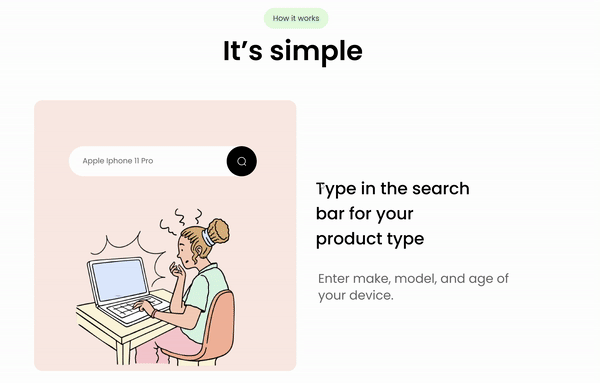
A digital platform that informs tech owners to responsibly dispose of their e-waste through data services and rewards.
Project Details
Role:
User Experience Designer
Tools Used: Figma, Miro
Duration:
15 weeks
Category:
Electronic Waste
Goal
To make electronic waste recycling easy and secure through data management of personal smart devices.
My Role
I played the role of a UX designer. I was involved with each stage of the process, which included:
-
User Research
-
Interviews
-
Ideations
-
Prototyping
-
Presenting (creating the visual style of the entire team)
Every 4 seconds, a person's digital information is stolen. Our personal devices store so much information and when we replace them, we forget to purge that data.
The Problem
People want to make sustainable choices with their tech devices, but they don't have the knowledge or resources to make informed decisions.
Did you know?
Data shows that 70% of the toxicants come from
e-waste, and 80% of
e-waste is not properly recycled.
Opportunity
Global e-waste is thought to hold roughly 60 billion U.S. dollars' worth of raw materials such as gold, palladium, silver, and copper.
MARKET SIZE
$60 Billion
RECYCLED
20-30%
NOT RECYCLED
70-80%
THE IDEA
A trustworthy digital platform that provides data services and disposal solutions for your electronics

How it works

Features

How offering data services leads to more E-waste recycling.
As a team, we split our project into two stages
Research
Expert Interviews
Company Interviews
Stakeholder Mapping
Market Study
Execution
Service Testing
Workshopping
Prototype Creation
Prototype Testing
The research showed four themes.
-
Identified through user and demographic research
-
22 stakeholder interviews
-
13 consumer interviews
-
9 expert interviews
-
In the span of 4 months.
Convenience
How might we make repair and disposal of tech product as easy and convenient as possible?
Knowledge
How might we make information about repair and recycling electronic products more accessible to electronic owners?
Trust
How might we make data and information regarding how organizations recycle tech products, more transparent and credible?
Value
How might we leverage other mindsets that are more motivating than environment alone?
We then matched this with the market
To learn from companies doing well in certain area, and adopting these ideas into our product.

To figure out where we stood among them.

Findings
- Find Incentive: Consumer: Incentives are important for engagement.
- Build Trust: Incorporating a community element on the website can help build trust
- Increase Usability: Clear Instructions, Easy to Use, Easy to Read, Accurate.

A systems study, showed the stakeholders at play.
Our research showed multiple touchpoints from where users could deal with their personal waste. However, there was nothing much to do regarded data servicing.
From there we spoke each domain expert.

“Education and building right platform creates trust, motivated activity, theoretically your ideas are unbelievably good.”
—John Shegerian, CEO of ERI
“Humans hate uncertainty, they like to know what to expect.”
—Kelly Wu, Consumer
“I am surprised by how much money corporations and businesses will put into anything that makes them look more sustainable.”
—Megan Hale, Founder of Team Repair
“The existing websites are so hard to navigate, and that is why I don't use them.”
—Renpeng Sun, Consumer
And concluded our research phase with actionable product features.
Value
Tax breaks for donation and recycling
Gamification of point system for rewards
Reward System based on cash and equal value
Trust
Offering KAI guarantee, for repairs
Partnership with only certified recyclers
Convenience
Tutorial on self data services
Premium services for assisted
Knowledge
Recycling tracking data
Data services step by step guide
Product Testing Phase
Service Concept

Service Testing (part 1)

Findings
Need more evidence
Easy access to location
Reduce waiting times
Not at events
Testing Parameters
In person workshop
11 people, ages 23-45 NYC residents
Data backup and Data securing was a need
Service Testing (part 2)

Testing Parameters
Findings
Data services are needed
Paid service in highly demand
More security,
more recycling
Reward is incentivizing, options are satisfactory
Field Test
10 people, ages 23-45 NYC residents
Data services are needed and people will want the rewards
Business Model testing

Findings
Premium service
Paid service
Modest Price Range
Need to pivot to a
not for profit model
Testing Parameters
In person workshop
11 participants, ages 23-45 NYC residents
There is a demand for this service, and people will choose to pay.
Brand Voice Testing

Testing Parameters
A/B test four distinct concepts
92 participants, ages 23-45 NYC residents
Professional and informative would score higher

Findings
Product Building Phase
Wireframing to product

The basic structure of the website followed a simple style flow. Captivating text and imagery are used as a hook to bring visitors into the site
A two-column approach kept key information at the forefront, with links allowing to navigate on other pages for more information.
Simple page format segments crucial information into categories. Call to action buttons with present at top bar menu and at the end of the landing page.






Key Takeaways
From Jury Panel
- Resonated with the novel concept.
- Suggested to input a mail in service for owners for ease of use
From Self
- More time to conduct usability testing of the website, that would enable the build of a mobile app as well.
- Introduce a smoother survey to categorize electronic device health for adequate valuation of reward.










